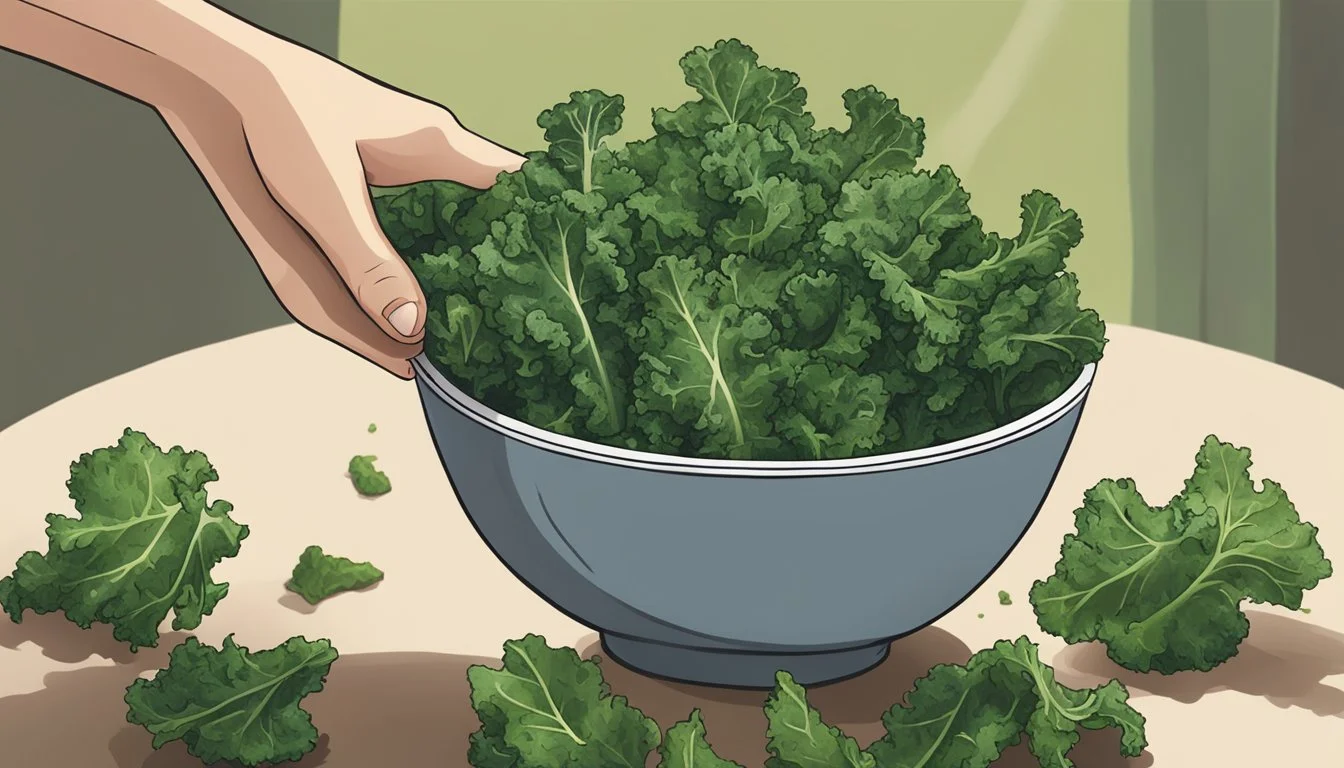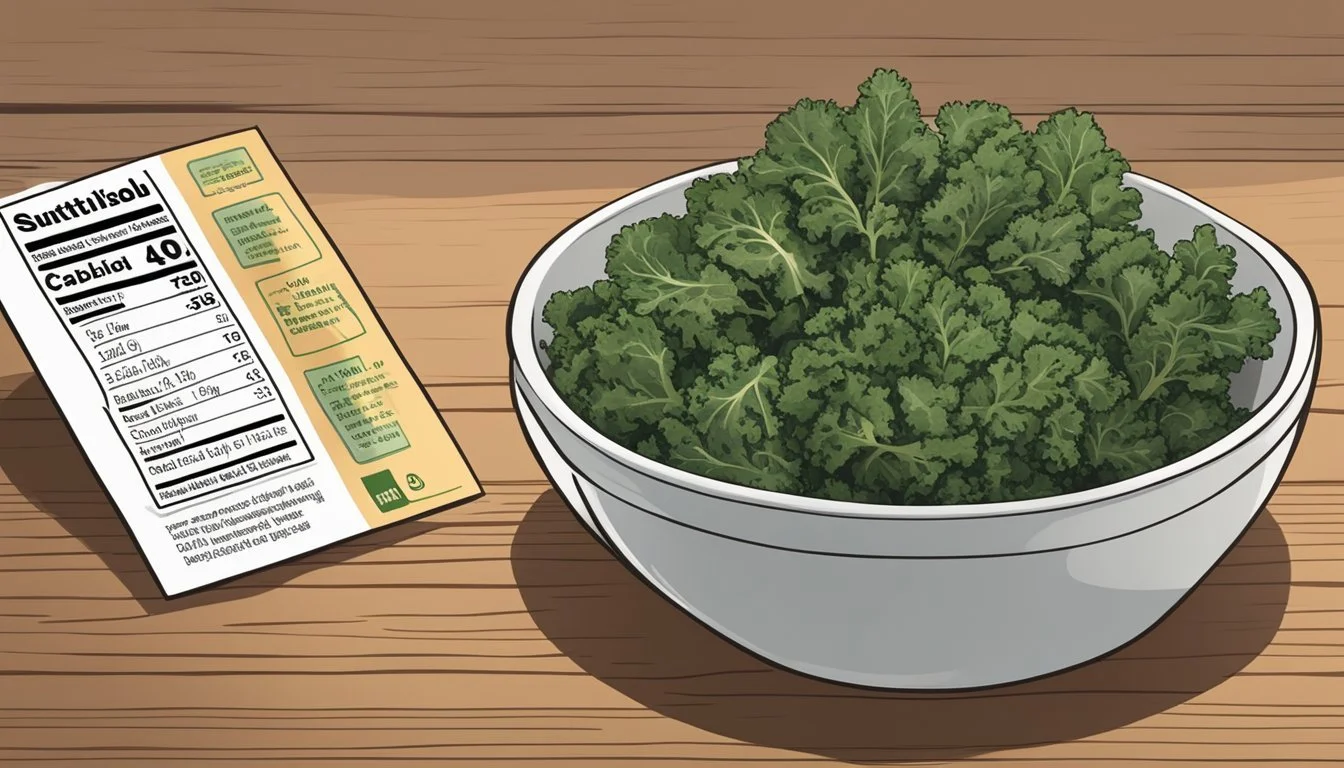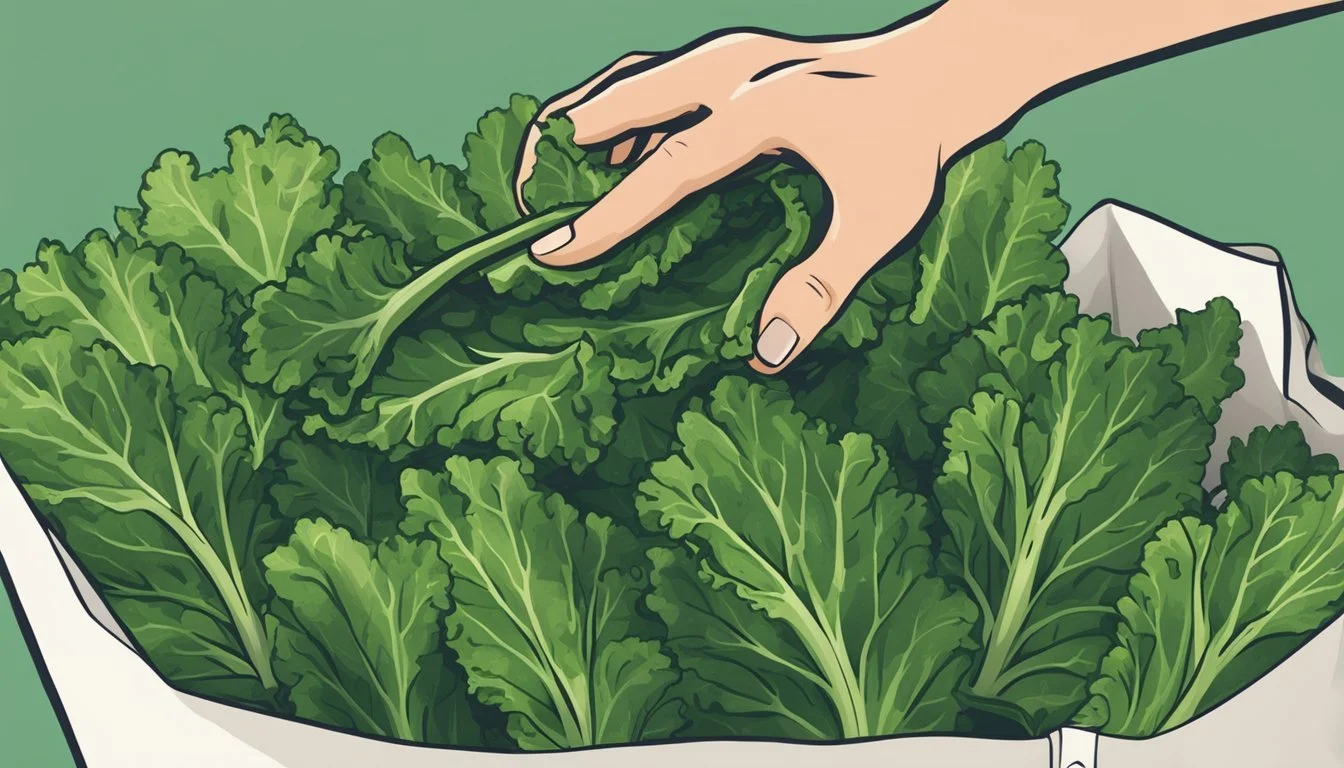How do you eat kale chips?
A Guide to Enjoying This Healthy Snack
Kale chips have emerged as a favored snack for those seeking a healthy and flavorful alternative to traditional potato chips. Made by baking or dehydrating kale leaves until they are crispy, kale chips offer a satisfying crunch and can be seasoned in a variety of ways. They are rich in vitamins A, K, and C, making them not just a delicious treat but also a nutritional powerhouse.
Eating kale chips can be as simple as popping them into one’s mouth like any other snack food. However, due to their delicate nature, they are best consumed soon after they are made to maintain their crispness. This snack is versatile, often used as a standalone treat, or as a crunchy addition to salads and grain bowls to add texture and flavor.
Selecting the Best Kale
When making kale chips, the choice of kale is pivotal. It impacts not only the taste but also the texture of the final product.
Types of Kale
Kale comes primarily in several varieties suitable for kale chips:
Curly Kale: This type of kale has ruffled leaves and a hearty flavor. It's often bright to dark green.
Lacinato Kale (also known as Tuscan kale or Dinosaur kale): It has longer, flat leaves that are a deep green color. The texture is slightly more delicate than curly kale, and it has an earthier taste.
Red Russian Kale: This kale has flat, fringed leaves that range in color from green to reddish-purple. It has a sweet and slightly peppery flavor.
Each variety lends a different texture and taste to your kale chips. Curly kale is most common, but Tuscan kale can result in crispier and thinner chips.
Preparation of Kale
For the preparation of kale for chips:
Trim: Remove the leaves from the stems of the kale. Stems should be discarded as they are too tough to eat after baking.
Rinse and Dry:
Rinse the kale leaves under cool running water to remove any dirt or debris.
Use a salad spinner to spin dry the leaves thoroughly. If a salad spinner is not available, pat the kale dry with towels.
Ensuring that the kale is fully dry is critical, as any leftover moisture can hinder the crisping process.
Select a fresh bunch of kale with vibrant leaves for the best result. Avoid leaves that show signs of wilting or yellowing, as these are past their prime.
Ingredients and Substitutions
To craft the perfect kale chips, one needs both essential ingredients and a variety of flavorings to suit their taste. The ability to substitute ingredients ensures that people with different dietary preferences or restrictions can still enjoy this crunchy snack.
Essential Ingredients
Kale: The foundation of kale chips is, unsurprisingly, kale. One should choose fresh, curly kale for its texture, but flat kale can also be used as a substitute.
Oil: To achieve crispy kale chips, oil is important. Olive oil is a common choice for its flavor, but for a neutral taste, one may opt for avocado oil or coconut oil.
Salt: A critical ingredient, sea salt works best for enhancing the natural flavor of kale, but table salt can be employed if sea salt is unavailable.
Flavor Enhancements
Kale chips can be customized with a vast array of seasonings to elevate their taste. Here are some popular options and substitutions:
Cheese: For a cheesy flavor, nutritional yeast can mimic parmesan cheese and is an excellent vegan choice.
Spices: Classic spices such as garlic powder, cumin, and chili powder bring depth to kale chips. Smoked paprika can add a distinctive smokiness.
Heat: For spice lovers, red pepper flakes provide a nice kick. Alternatively, cayenne pepper can be used for a more uniform heat distribution.
Savory Blends: Italian seasoning or everything bagel seasoning can transform the chips with a complex blend of flavors.
Salt and Pepper: Lastly, a simple dash of black pepper can be paired with salt for a timeless taste profile.
Each ingredient can be adjusted to preference, making kale chips a highly customizable and enjoyable snack.
Step-by-Step Baking Instructions
To ensure the successful creation of crispy kale chips, one must follow a meticulous process of mixing the ingredients and executing precise baking techniques. Thoroughness at each step, from ingredient preparation to final baking, guarantees a satisfyingly crunchy snack.
Mixing Ingredients
In a large bowl, lay out freshly washed and thoroughly dried kale that has been torn into bite-sized pieces, discarding any tough ribs. Drizzle these kale pieces with a small amount of olive oil. Using one's hands or a utensil, massage the oil into the kale, ensuring that the leaves are evenly coated without being drenched in oil. The goal is for each piece to be lightly covered which aids in even crisping. Next, season the kale according to preference; common seasonings include sea salt, garlic powder, or nutritional yeast for a cheesy flavor.
Layering and Baking
For baking, preheat the oven to a low temperature, around 275°F (135°C), to dehydrate the kale slowly without burning it. On a baking sheet lined with parchment paper or a silicone baking mat, spread the kale in a single layer. It is crucial to avoid overcrowding to promote even baking and prevent steam from creating soggy chips.
Place the baking sheets in the preheated oven and bake for about 20-30 minutes, rotating the sheets halfway through for uniform cooking. Monitor closely towards the end to prevent any burning. The kale chips are done when they are crisp to the touch and slightly browned at the edges. After removal from the oven, allow them to cool slightly; they will continue to crisp up as they cool. Serve the oven-baked kale chips as a nutritious, low-calorie snack.
Nutrition Information
Kale chips offer a nutritious alternative to traditional snacking options, with a balance of essential vitamins and nutrients. They contain calories and fat which vary depending on the preparation method, as well as a range of vitamins and minerals beneficial for health.
Calorie and Fat Content
A standard 1-ounce bag of kale chips typically contains 140 calories and can have around 4 grams of fat, depending on the added ingredients such as oils or seasonings. The fat content mainly consists of healthier unsaturated fats when olive oil or similar oils are used for baking.
Vitamins and Minerals
Kale chips are a valuable source of vitamins and minerals. They are particularly rich in vitamin A, vitamin C, and B vitamins including vitamin B6, B1 (thiamine), and B2 (riboflavin). Minerals such as calcium, potassium, iron, and magnesium are also present in significant amounts. They provide dietary fiber as well, aiding in digestion. Here's a snapshot of the nutrient profile in a 1-ounce serving of kale chips:
Vitamin A: Approximately 200% of the Daily Value (DV)
Vitamin C: Nearly 200% of the DV
Vitamin B6: 11% of the DV
Calcium: 15% of the DV
Potassium: 14% of the DV
Iron: 8% of the DV
Magnesium: 11% of the DV
Fiber: About 3 grams
The exact nutrient content can vary greatly between different brands and recipes, with some using nutritional yeast to add a cheesy flavor and additional nutrients such as B vitamins and fiber.
Additional Cooking Methods
After mastering the oven method, one can explore other techniques to create kale chips with unique textures and flavors. Two such methods are the air fryer and dehydrator.
Air Frying
An air fryer offers a quick and efficient way to make kale chips. It circulates hot air around the leaves, creating a crunchy snack in less time than an oven. To make air fryer kale chips, one should:
Preheat the air fryer to about 375 degrees Fahrenheit (190 degrees Celsius).
Prepare the kale as one would for oven baking, ensuring it is dry and torn into pieces.
Lightly coat the kale in oil to help it crisp up during cooking.
Place the kale in the fryer basket, ensuring pieces do not overlap for even cooking.
Cook them for approximately 4-5 minutes, then check for crispiness. If needed, continue to cook for another 1-2 minutes.
It's crucial to monitor closely, as the air fryer can crisp the kale very quickly.
Dehydrating
For those who prefer their kale chips extra crispy and with a longer shelf life, dehydrating is the method to choose. A dehydrator gently removes moisture over several hours, which preserves the chips and intensifies their flavor. Steps to make chips using a dehydrator include:
Wash and thoroughly dry the kale, tearing it into bite-sized pieces.
Massage the kale with a little oil to improve texture and taste.
Place the kale on the dehydrator trays in a single layer.
Set the dehydrator to 125 degrees Fahrenheit (52 degrees Celsius).
Dehydrate the kale for 4-8 hours, checking periodically for the desired crispness.
Dehydrators can provide a more consistent texture and are ideal for larger batches.
Storing and Keeping Them Crispy
Proper storage is crucial for maintaining the crispiness of kale chips. Whether one is planning to consume the kale chips within a few days or looking for a long-term solution, the following strategies ensure that kale chips retain their satisfying crunch.
Short-Term Storage
For those intending to enjoy their crispy kale chips within a few days, the best approach is to allow the chips to cool completely to room temperature after baking to prevent any residual steam from softening them. Storing kale chips in an airtight container is a standard practice. To further absorb moisture, one may introduce a thin layer of dry white rice at the bottom of the container or place a paper towel above and below the chips. Storing the container in a dark, cool place can extend their crispiness for 2-3 days.
Paper bags offer an alternative solution; their porous nature helps to soak up additional moisture. If opting for a paper bag, it should be folded tightly to minimize air exposure.
Long-Term Solutions
For kale chip enthusiasts looking to preserve their snacks (What wine goes well with snacks?) for an extended period, freezing offers an ideal solution. One should start by ensuring the kale chips are thoroughly dry and crisp. Placing the chips in a freezer-safe container with a piece of parchment paper can help maintain their texture. For best results, kale chips should be stored in the freezer and thawed at room temperature before consumption. Properly frozen, kale chips can last for several months while still retaining a good degree of their original crispiness.
Creative Variations and Flavors
Kale chips can be transformed into a spectrum of flavors through the addition of various spices, cheeses, and seasoning blends, providing a satisfying alternative to traditional snack chips.
Cheesy Variants
Cheese lovers can rejoice with these cheesy kale chip variations. Firstly, Nacho flavored kale chips can be achieved by adding a blend of nutritional yeast for a cheesy flavor, coupled with a combination of garlic powder, onion powder, ground chili powder, and paprika for that classic nacho taste. For those who appreciate a more traditional cheese flavor, incorporating Parmesan cheese into the kale before baking provides a nutty and rich profile. Another dairy-free alternative is using nutritional yeast to create a Cheddar flavor, giving the chips a tangy and rich cheese-like taste without the use of actual dairy.
Spicy and Herbed Options
For those who favor a bit of heat, spicy kale chip variations are plentiful. A simple yet effective option is adding red pepper flakes before baking to introduce a straightforward spicy kick. The popular Chili Lime variant marries the warmth of chili powder with the zestiness of lime for a tangy and spicy experience. Furthermore, herbed kale chips can be created using a Ranch blend of dried parsley, dill, garlic powder, onion powder, and dried onion flakes. Lastly, an Everything Bagel seasoning can offer a complex array of flavors including poppy seeds, sesame seeds, garlic, and onion for a savory and textured finish. These seasoning options can be tailored to personal heat preference and can be complemented with a cool, creamy dip to balance the flavors.
Kale Chips as Part of a Diet
Kale chips can be a nutritious and versatile snack that fits into various dietary plans. They offer a satisfying crunch and are available in a range of flavor profiles suitable for low-carb, keto, gluten-free, and vegan diets.
Low Carb and Keto-Friendly
Kale chips are a suitable option for individuals following a low carb or ketogenic diet. They contain minimal carbohydrates, and most of these carbs come from fiber, which is subtracted when calculating net carbs — vital in keto dieting. A typical 1-ounce serving provides 7 grams of carbohydrates and 3 grams of fiber, yielding 4 net carbs.
For keto dieters, it is important to check the ingredients for added sugars or starches that can increase the carb count. Unflavored kale chips or those seasoned simply with salt, olive oil, or other fats are more likely to align with the ketogenic profile.
Gluten-Free and Vegan Options
People with gluten intolerance or celiac disease can safely incorporate kale chips into their diet, as they are naturally gluten-free. Nonetheless, it is crucial for these individuals to double-check that the kale chips they select are not processed in a facility that handles gluten-containing products to avoid potential cross-contamination.
For vegans, kale chips can serve as a healthy snack that supports their plant-based lifestyle. Many brands offer kale chips seasoned with vegan-friendly ingredients like nutritional yeast, which provides a cheese-like flavor without the dairy. Individuals should look for kale chips that use plant-based oils and natural, animal-free seasonings to ensure the snack complies with vegan dietary standards.
Serving Suggestions
Kale chips offer a versatile snacking experience, easily fitting in as a standalone snack or complementing a variety of meals. They are celebrated for their crisp texture and can be a healthy alternative to traditional chips.
As Snack or Appetizer
When enjoyed as a snack or appetizer, kale chips are best served fresh and crispy. For a healthy snack option, they can simply be placed in a bowl and enjoyed on their own. Alternatively, one can elevate their appetizer game by presenting the kale chips with a variety of dips, such as hummus or Greek yogurt-based dips, to add a creamy contrast to their crispness.
Pairing with Meals
Kale chips can also complement meals, adding a crunchy texture and nutritious punch. They pair excellently with:
Salads: Crumbling kale chips atop a kale salad adds an extra layer of texture.
Soups: Serving the chips on the side of a warm soup makes for a delightful experience.
By incorporating kale chips into meals or enjoying them as a standalone snack, they serve as a guilt-free indulgence that can satisfy savory cravings.
Commercial Kale Chips
Commercial kale chips provide a crunchy alternative to traditional snack options like popcorn or Doritos, offering a healthier option that often contains fewer preservatives. The market boasts a variety of brands, each with unique flavors and ingredient profiles.
Popular Brands:
Rhythm Superfoods: Known for creativity in their flavorings.
Kale Krunch: Offers organic varieties.
Brad's Plant-Based: Renowned for using raw ingredients.
Availability:
Prospective buyers can typically find these chips in health food stores or major supermarkets. Some brands are available online, with the possibility of purchasing through an affiliate link.
Ingredients & Flavors:
Most commercial kale chips forgo artificial preservatives, embracing simplicity with natural spices and seasonings. Flavors range from sea salt and vinegar to spicy jalapeño and cheesy nacho, leveraging nutritional yeast or cashew-based sauces to mimic a Dorito-like zest without the use of dairy.
Nutritional Comparison:
A straightforward table showcases the benefits of kale chips compared to other snacks:
Snack Type Preservatives Caloric Content Nutritional Value Kale Chips Minimal Low to Moderate High Popcorn Variable Moderate Moderate Doritos High High Low
They serve as a fibrous, nutrient-packed snack that satisfies the need for crunch without the guilt commonly associated with snack-time indulgences.







